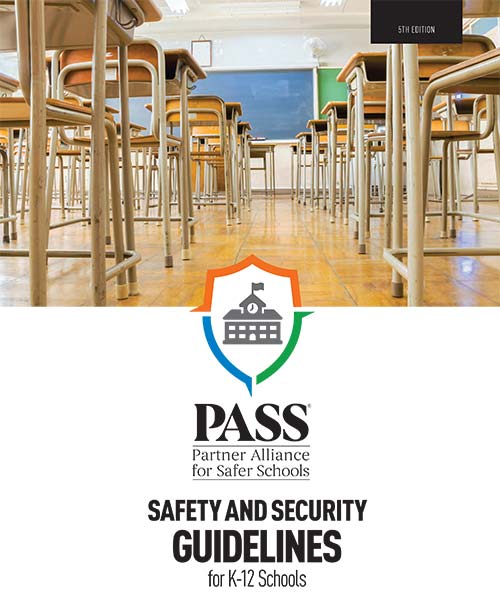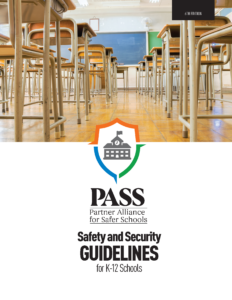How to Work with Schools to Integrate PASS Guidelines
“What we’re doing is changing a culture, changing a dynamic within schools.”
— Scott Lord

Meet Scott Lord, a self-proclaimed “code junky” and life safety integrator since 1999. Lord currently works as a solutions consultant for Electronic Consulting Company (ECC) and serves on the 730/731 technical committee for the National Fire Protection Association. He’s also one of PASS’s founding members and serves on the advisory council as the Resource Committee Chair. Here, Lord shares with us his involvement with PASS and how he’s worked with schools over the years to integrate PASS Guidelines into their safety and security plans.
How Did You First Get Involved with PASS?
In 2013, Lord sat down in Atlanta with 20 other industry professionals determined to address school safety and security head-on. After the Columbine shooting, 9/11 and ultimately the Sandy Hook shooting in 2012, the issue was becoming more of a hot topic. Lord had already been working with several partner organizations but there was no movement. They were having to strategize in a piecemeal fashion in the absence of any federal regulatory oversight. Over the course of two days, Lord and Jim Crumbley, the Atlanta cohort, devised a mission and vision, forming a committee including himself, Jim and two other people that would become PASS.
What Led You to This Work?
Lord’s wake-up call happened around 2001, right after 9/11. The terrorist attack combined with the Columbine school shooting just a couple of years prior gave him visions of someone walking into his kids’ school with a suicide vest. “I had just started working on security systems at Sprint,” says Lord, “and I was struck by how secure those buildings were for just intellectual property. Meanwhile, I could literally walk into any door at my kids’ school. It was laughable.”

Pitch Us PASS: What’s It All About?
PASS provides schools with a roadmap to navigate the complexities of implementing a comprehensive approach to safety and security. PASS resources can help schools adopt effective and appropriate solutions to safety and security challenges, recognizing that every school is unique and has unique risk profiles. “It’s not about selling technology in order to keep kids safe,” Lord says. “What we’re doing is changing a culture, changing a dynamic within schools. We have the unique ability to do that by bringing together experts in this field.” What’s different about PASS is, “we don’t want our guidelines to become an NFPA code book. We want school administrators to understand within an hour or two what message we’re trying to convey.”
What Sort of Threats Do the PASS Guidelines Help with?
“The threats to school safety and security are so unique,” Lord says. School is where your kids will spend 11,500 hours over their K-12 experience, and making a school secure isn’t just about active shooter events. Our public schools will have to confront nearly one million serious violent events in a school year, including bullying, suicide, self-harm, drug use, and the impacts of social media, among other challenges. Lord has gotten feedback from school districts that revamping their safety and security measures vis-à-vis the PASS Guidelines has allowed them to proactively spot students who may be headed for trouble. The schools were then able to intervene in order to get those students on a better path.
What Are Some of the Obstacles You Face Working with Schools?
Lord’s primary focus is simple: educating school administrators. “These are educators, not integrators,” he says. “Any time a school is approached by someone offering them a new technological solution to school safety and security, I want schools to be able to say, ‘This is our plan.’” The pushback he encounters from schools is usually one of three things:
“That Won’t Happen Here”
No school administrator wants to believe that level of violence could happen inside their walls. And yet PASS hears “That won’t happen here” after nearly every violent event that makes it to the national news.
“No Money”
When Lord first started approaching schools about enhancing their security systems, school administrators’ immediate reaction was the same: no money. “Schools have no money unless it’s related to learning. Football stadiums, theaters, AVs, intercom systems—those are the focus.” Principals would say that security was important, but there was no program in place. That’s when Lord realized he wanted to dedicate his life to helping schools understand the importance of prioritizing school safety and security.
Reactive Rather than Proactive Planning
It’s difficult getting schools to think proactively about safety and security. “We all thought Columbine was one unique incident,” says Lord. Schools want to make sure their buildings are safe, but they’re worried about how to justify it not only to the school board, but to parents as well. How do they keep their schools from feeling like prisons? Conversely, the presence of security equipment can give parents the impression that the school or area is inherently unsafe, and so they pull their kids out of the school.
The Guidelines are tailored to each school’s unique needs, with four tiers from basic Tier 1 recommendations to more advanced safety and security systems at Tier 4. Lord acknowledges he has to meet schools where they are, even if he would like to see all schools at Tier 4 thinking. “The response I sometimes get is, ‘I’ll be retired by the time we get there.’ That’s when I respond, ‘At least there will be a system in place for the next guy.’”

If You Could Change One Thing About School Districts, What Would It Be?
In an ideal world, says Lord, every school district would have at least one administrative/district level person whose sole function is safety and security. He recognizes this isn’t always feasible for smaller school districts. But having this top-down approach translates into a culture of safety that permeates the organization. “Teaching our kids is the most important thing,” says Lord. “Students learn better when they aren’t in fear for their safety.”
Tell Us a Success Story
Lord’s approach has always been about being a trusted advisor to each and every client. He does this by bringing resources to the schools he works with so he can have a seat at the table when safety and security conversations are happening. A great example of this was in 2001, with one of Lord’s first clients. Lord did a full redesign with a school district. A bond had just been passed for schools to protect themselves against natural disasters typically covered by Federal Emergency Management Agency (FEMA) funds. Unlike most school districts Lord had worked with over the years, this new superintendent was proactive, wanting to use the bond to secure his schools against more than just weather emergencies. “I don’t want an active shooter event at my school,” the superintendent told him.
Within a few months, Lord had the district set up so that school doors were only unlocked during pick-up and drop-off hours. Alerts were set to notify administrators when the doors were unlocked. They also worked with the local police department to set up a three-man SRO team. “The district had nine buildings,” says Lord. “I started wondering, what sort of impact could we have on the bigger districts?”
“This is what I’m doing with the rest of my life. How do we secure schools strategically and as a process? Schools are experts in using new methods in technology and processes to educate our kids. My mission is to use the experts in the security field to provide the same plans, process, and technology to keep our kids safe. And we can do that through PASS.”
The Partner Alliance for Safer Schools (PASS), a nonprofit 501(c)(3), brings together expertise from the education, public safety, and industry communities to develop and support a coordinated approach to making effective and appropriate decisions with respect to safety and security investments. You can download the complete PASS Guidelines here, or check out our PASS Safety and Security Checklist for quick tips on how to get started. These resources—as well as whitepapers on various topics such as barricade devices, lockdown drills, and more—are available at no cost.
Categories
- Access Control
- Classroom Door Locks
- Crime Prevention Through Environmental Design
- Cybersecurity
- Duress Alarm
- In the News
- Legislation
- Lockdown Drills
- New Technologies
- PASS Advisory Council
- PASS Board of Directors
- PASS Partners
- PASS Recommendations
- Preparedness
- Safe School Week
- Safety & Security Guidelines
- School Safety & Security
- Security Best Practices
- Video Surveillance

Ready to get the Guidelines?
The most comprehensive information available on best practices specifically for securing school facilities, vetted extensively by experts across the education, public safety and industry sectors.
